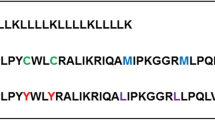Abstract
Earlier analyses of the physical chemistry of lung surfactant (LS) are rejected on the grounds that the definition of surface tension is not complied with. Furthermore, with 1 or 2 exceptions the devices used to measure the properties of LS have given misleading information. On the other hand, a protein-free formulation of an artificial lung-expanding compound (ALEC) consisting of a 7:3 mole/mole mixture of dipalmitoylphosphatidylcholine and phosphatidylglycerol seems to function as a reasonably good substitute for natural LS in very premature babies. It has the following necessary properties. It spreads rapidly and spontaneously at an air/water interface at 37°C, reducing the surface tension of water by about 2/3. The unsaturated phosphatidylglycerol (PG) moiety can be squeezed out of the mixed monolayer by rapid overcompression (equivalent to exhalation) and is irreversibly lost to the surface system by reassembly into liposomes. The residual dipalmitoylphosphatidylcholine (DPPC) becomes progressively enriched to the point that, at 37°C, it condenses out as a solid phase so rigid that it prevents the alveolae from collapsing. The preparation is protein-free.
It is suggested that this simple mixture of 2 phospholipids exhibits both thermodynamic (equilibrium) forces and the consequences of kinetic forces during the course of a compression/decompression cycle on a trough. Likewise, during a respiratory cycle, the alveolae may be kept open (or more precisely, the liquid lining the alveolae is prevented from filling them up) at full expiration by the presence of a permanent residue of almost pure DPPC which, being condensed (solid) at 37°C, is incompressible. The work of extending the uncovered air/water interface, upon inspiration, is reduced by replenishment from the stockpile of dry surfactant as though from a lamellar body. The respiratory cycle is thus seen as a dynamic sequence of refinement, ablution, and replenishment of phospholipid molecules.
Similar content being viewed by others
References
Bangham AD (1980) Breathing made easy. New Scientist 7th February 405–407
Bangham AD, Miller NGA, Davies RJ, Greenough A, Morley CJ (1984) Introductory remarks about artificial lung expanding compound (ALEC). Colloids Surfaces 10:337–341
Bangham AD, Morley CJ, Phillips MC (1979) The physical properties of an effective lung surfactant. Biochim Biophys Acta 573:552–556
Comroe JH Jr (1977) Premature science and immature lungs. Am Rev Respir Dis 116
Enhorning G (1977) Pulsating bubble technique for evaluating pulmonary surfactant. J Appl Physiol 43:198–203
Gaines GL, Jr (1966) Insoluble monolayers. Interscience Publishers, New York
Goerke J (1974) Lung surfactant. Biochim Biophys Acta 344:241–261
Hawgood S, Benson BJ, Hamilton RL Jr (1985) Effect of a surfactant associated protein and calcium ions on the structure and surface activity of lung surfactant. Biochemistry 24:184–190
Hildebran JN, Goerke J, Clements JA (1979) Pulmonary surface film stability and composition. J Appl Physiol 47(3):604–611
Hill MW (1974) The effect of anaesthetic-like molecules on the phase transition in smectic mesophases of dipalmitoyl lecithin. Biochim Biophys Acta 356:117–124
Hills BA (1982) What forces keep the air spaces of the lung dry? Thorax 37:713–717
Hills BA (1983) Pulmonary surfactant system In: Cosmi EV, Scarpelli EM (eds): Symposia of the Giovanni Lorenzini foundation, Vol. 16. Amsterdam, Elsevier Science, pp 17–32
Morley CJ et al: Ten-centre trial of artificial surfactant in very premature infants; Morley CJ, Gore SM, Greenough A, Miller NGM, Bangham AD, Pool J, Wood SW, South M, Davis JA, Vyas H, Hopkins IE, Milner AD: Randomized trial of artificial surfactant at birth.
Pattle RE (1955) Properties, function and origin of the alveolar lining layer. Nature 175:1125–1126
Scarpelli EM, Kumar A, Clutario BC (1983) Pulmonary surfactant system. In: Cosmi EV, Scarpelli EM (eds) Symposia of the Giovanni Lorenzini foundation, Vol. 16. Elsevier Science, Amsterdam, pp 3–16
Watins JC (1968) The surface properties of pure phospholipids in relation to those of lung extracts. Biochim Biophys Acta 152:293–306
Weis RM, McConnell HM (1984) Two-dimensional chiral crystals of phospholipid. Nature 310:47–49
Author information
Authors and Affiliations
Rights and permissions
About this article
Cite this article
Bangham, A.D. Lung surfactant: How it does and does not work. Lung 165, 17–25 (1987). https://doi.org/10.1007/BF02714417
Accepted:
Issue Date:
DOI: https://doi.org/10.1007/BF02714417




